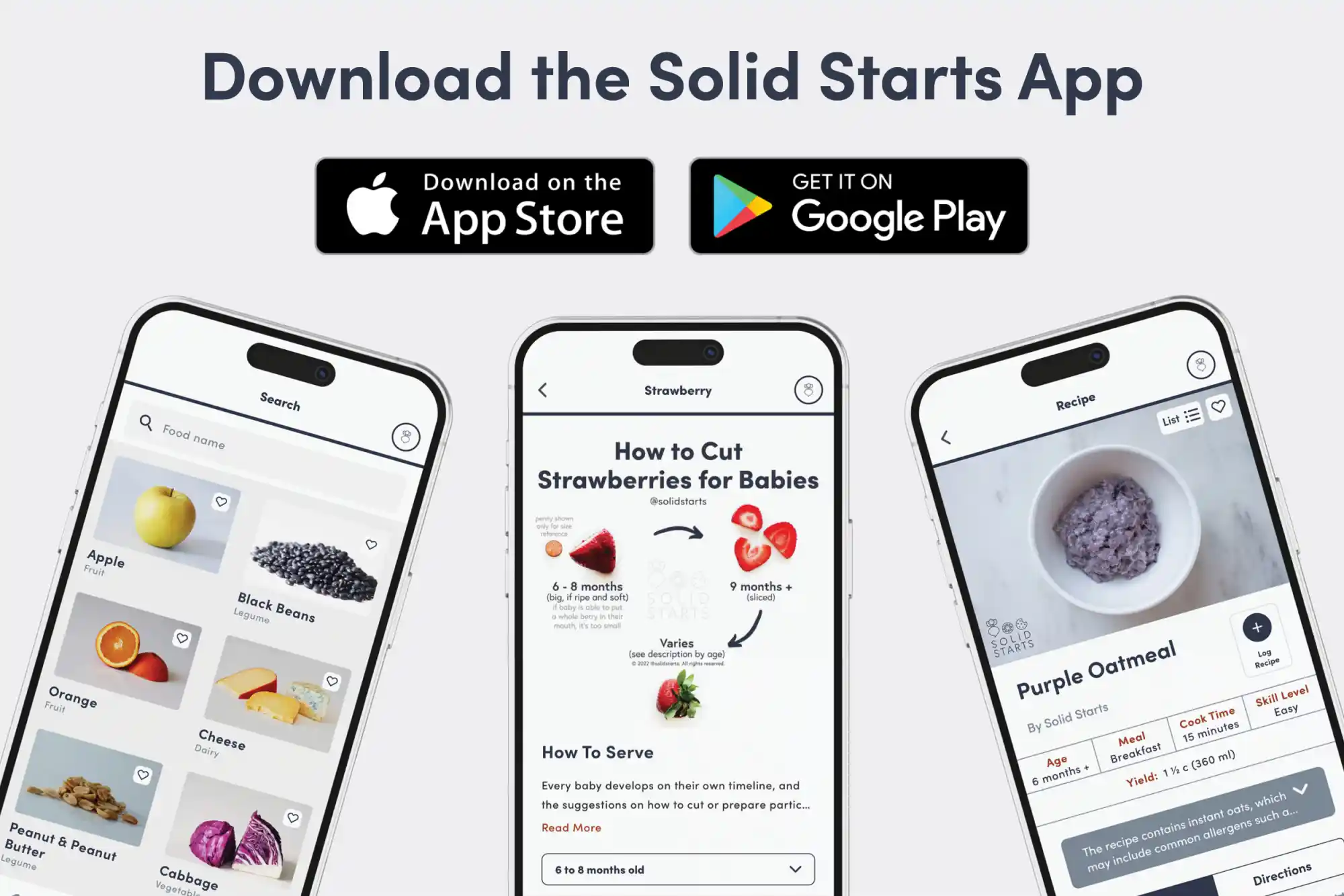Access our First Foods® Database in the Solid Starts App.
Learn moreLabneh
Dairy
Age Suggestion
6 months
Iron-Rich
No
Common Allergen
Yes

When can babies have labneh?
Labneh may be introduced as soon as baby is ready to start solids, which is generally around 6 months of age. Choose pasteurized labneh to reduce the risk of foodborne illness.
Labneh is a type of cheese made from drained, salted kefir or yogurt with origins in the fertile lands that connect Africa, Asia, and Europe. Also called laban, labne, or lebni among other names, this cheese has long been prized, both for its versatility and for the way it allowed yogurt to be preserved and used long after the milking season was over. Taste varies widely, depending on whether labneh is made from cow, goat, or sheep milk and how long it is drained. Fresh labneh is creamy, often used as a dip or spread, while aged forms of labneh, such as labneh tabat, are typically shaped into balls and preserved in olive oil, extending the cheese’s shelf life still further.
How do you serve labneh to babies?
Every baby develops on their own timeline, and the suggestions on how to cut or prepare particular foods are generalizations for a broad audience.
6 months old +:
Serve soft, scoopable pasteurized labneh in a bowl and let baby self-feed. Feel free to drizzle olive oil on top and mix with finely chopped herbs but avoid adding honey, which should not be offered before the first birthday due to its association with infant botulism. Alternatively, offer labneh mixed into other soft, scoopable foods, spread onto strips of toast, or mixed into rice and lentil dishes to form easy-to-grab balls.
12 months old +:
Continue to offer soft labneh on its own, or paired with other foods for dipping (like bread or vegetables). Serve labneh with a small bowl of seasoning on the side and invite toddlers to flavor the cheese as they see fit. To encourage the use of utensils, pre-load a spoon and rest it next to the bowl for the toddler to pick up. To serve firm labneh, offer small crumbles on their own or as part of a meal.
Videos
Is labneh a choking hazard for babies?
It depends on the type. Labneh, when soft and scoopable, does not pose much risk, although firmer varieties of labneh, such as labneh balls, are firm, round, and slippery, qualities that increase choking risk. To reduce the risk, prepare and serve labneh in an age-appropriate way as described in the How to Serve section. As always, make sure you create a safe eating environment and stay within an arm’s reach of baby during meals.
Learn the signs of choking and gagging and more about choking first aid in our free guides, Infant Rescue and Toddler Rescue.
Is labneh a common allergen?
Yes. Labneh is often made from cow’s milk, which is a common food allergen in young children, accounting for about one-fifth of all childhood food allergies in the United States. Keep in mind that dairy products from other ruminants such as sheep, goat, and buffalo may provoke similar allergic reactions to cow’s milk dairy products. If baby is allergic to dairy, know that it is an allergy that often disappears with time. Research shows that the majority of children with cow's milk allergy will outgrow it by age 6, and many babies with milder symptoms of milk protein allergy (which can show up as painless blood in stool) are able to successfully reintroduce cow's milk as early as their first birthday, with the guidance of their doctors.
Milk is a known trigger of food protein-induced enterocolitis syndrome, also known as FPIES. FPIES is a delayed allergy to food protein which causes the sudden onset of repetitive vomiting and diarrhea to begin a few hours after ingestion. Left untreated, the reaction can result in significant dehydration. Thankfully, like other forms of milk allergy, FPIES that presents early in life is generally outgrown by the time the child has reached 3-5 years of age. While the exact rates of FPIES are unknown, it is believed to be an uncommon condition (although better recognition of the disease has led to increased reporting in recent years).
Although it is not an allergy, lactose intolerance can result in gastrointestinal symptoms such as abdominal pain, bloating, and diarrhea, after ingestion of dairy items containing lactose. For those with older children who are lactose intolerant (keep in mind this is uncommon for infants and toddlers), some good news: compared with milk and certain other dairy products, many cheeses may be better tolerated by those with lactose intolerance, particularly aged cheeses, which have lower lactose content. Note that if your child is lactose-intolerant, it’s important to find calcium-rich foods to consume regularly to ensure a balanced diet and support bone health. Search for naturally low-lactose cheeses and dairy products labeled “lactose-free.”
If you suspect baby may be allergic to milk, consult an allergist before introducing dairy products like cheese. Based on baby’s risk factors and history, your allergist may recommend allergy testing, or may instead advise dairy introduction under medical supervision in the office. If the risk is low, you may be advised to go ahead and introduce dairy in the home setting. As with all common allergens, start by serving a small quantity on its own for the first few servings, and if there is no adverse reaction, gradually increase the quantity over future meals.
Is labneh healthy for babies?
Yes. Labneh is rich in protein, fat, calcium, vitamins A and B12, and probiotics. These nutrients work together to support brain development, bone density, skin health, immunity, growth and development, and the gut microbiome. Labneh is also rich in saturated fat, which is one of the most abundant types of fat in breast milk. In recent years, saturated fat has been scrutinized for its association with heart disease in adults, but research shows that it has its place as a part of a balanced diet, and that it may have a more neutral impact on the heart than previously thought. Choose pasteurized labneh to reduce the risk of foodborne illness.
While some forms of labneh can be high in sodium, the amount of sodium that babies eat tends to be low as they learn the skills to feed themselves. Sodium can also offer benefits like supporting baby’s electrolyte balance, hydration, and movement. While many health organizations recommend holding or reducing salt in food shared with baby, recent reviews of literature suggest that this may not be necessary. Furthermore, sharing family meals with salt has its benefits: baby has opportunities to explore a wider variety of food, share their family food culture, and practice eating a variety of textures.
Do I need to start solids with purees?
You can if you’d like, but there's no developmental need to start with textureless food. Babies can be served modified versions of what you eat. Use our First Foods Database to find how to safely serve any food.
What are some great first foods for babies?
There are many wonderful options. Look for foods that are easy for baby to feed to themselves, that are low in choking risk, and that offer nutrients babies need, such as iron. A few of our favorite first foods include cooked broccoli, oatmeal, and mango pits.
Our Team
Written by
Expert Tips Delivered to Your Inbox
Sign up for weekly tips, recipes and more!
Copyright © 2025 • Solid Starts Inc






